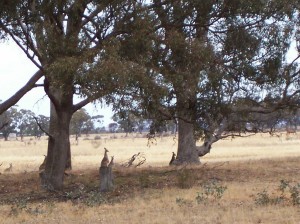Melton Gilgai Woodland in Harkness Road is mixed Grey Box/Yellow Gum woodland. The reserve is an area of natural bushland on the north-west fringe of Melton & is owned by Parks Victoria & is managed by Melton Shire for environmental & conservation purposes.
The woodland at first appearance looks dry & barren but it has a rich variety of vegetation & animal life. Many endangered plants find refuge here. Although the ground cover is sparse there is a variety of wildlife here. It is home to a large variety of native birds, including a number of endangered species. Endangered woodland birds such as Jacky Winter, Restless Flycatcher, Brown-headed Honeyeater, Brown Treecreeper & Diamond Firetail have all been recorded here. Large raptors such as Brown Goshawks & Whistling Kites nest here. Brown Goshawks nest here almost every year, changing nest sites every two or so years.
Over 100 kangaroos graze in grassland adjacent to the eastern edge of the woodland, while koalas (often carrying young) sometimes can be seen in the trees. Many birds that migrate from northern Australia make their summer homes here. Birds such as Dusky Woodswallows & White-browed Woodswallows return here in summer, year after year, to nest & raise their young. Dusky Woodswallows arrive in early Spring & leave in late Autumn. Some remain locally all year round. White-browed Woodswallows arrive in early Summer & depart late Summer, almost immediately after breeding. They do not visit Melton Gilgai Woodland every year however.
Several endangered birds have also been recorded here. Swift Parrots were observed feeding on Grey Box flowers here in April & May 2007. This makes Melton Gilgai Woodland of added importance as a resting & feeding point as these parrots migrate from their breeding grounds in Tasmania to northern Victoria & New South Wales in autumn, then back again in spring. Diamond Firetails returned to Melton Gilgai in 2015. They were recorded here on several occasions, by several observers in May, June, July 2014. Brown Treecreepers were also seen here in May, June, November 2009. They are also permanent residents in the small old growth woodland in the proposed Melton cemetery, a short distance from Melton Gilgai Woodland. They are resident in the nearby Long Forest Mallee. Melton Gilgai Woodland acts as a stepping stone in a corridor between Long Forest Mallee & the Cemetery woodland.
Another endangered species in Melton Gilgai is the rare Bullant (Myrmecia sp 17). These were discovered here on Saturday June 13th by Dr John Wainer, an ant expert from the Department of Primary Industry, who led a walk here, consisting of about 20 local environmentalists & naturalists) in search for the rare ant.
Despite the recent extended drought, there are thousands of tiny eucalyptus seedlings, several centimetres in height. The woodland appears to be undertaking its own recovery & regeneration now that there is no grazing here. Numerous Turkey Bushes (Eremophila desert) which are uncommon & vulnerable are a feature of this woodland.
Melton Gilgai Woodland is a small remnant of the large Grey Box woodland that once covered much of the Melton region, bordered by the large expanse of grassland that extended from Melton to the Maribyrnong River. The woodland is about a kilometer from the adjacent Long Forest Mallee, to which it is connected by lightly wooded privately owned paddocks. It is also connected to the nearby Pyrete Forest in the hills surrounding Toolern Vale, by wooded roadside verges. These two areas of bushland are rich in wildlife. Melton Gilgai depends upon these nearby large areas of bushland for its own wildlife. Connectivity to nearby bushland (via wooded corridors) is of vital importance to the continued presence of wildlife in this woodland remnant. Arnolds Creek (West) begins as a drainage line in cleared paddocks near Melton Gilgai Woodland
Birds of Melton Gilgai Woodland (as recorded by Melton Environment Group since 2007)
83 species
|
|
|
The swift parrot is listed as Endangered on the Commonwealth Environment Protection and Biodiversity Conservation Act 1999 & listed as a threatened taxon in Schedule 2 of the Victorian Flora and Fauna Guarantee Act 1988. The swift parrot population is estimated to number less than 2,500 mature individuals
*breeding
# summer migrant
^ winter migrant
@vulnerable
Melton Gilgai woodland is also home to over 100 kangaroos & occasionally several koalas, as well as several exotic foxes & hares.


Good to see we still have these untouch areas so close to home n when I’m near this area I’ve seen the swift parrot n near where I live in kurunjang on a few occasions. Bloody noisy n quick little guys. Good to see planting natives round the school has brought these guys past briefly on there flight south.